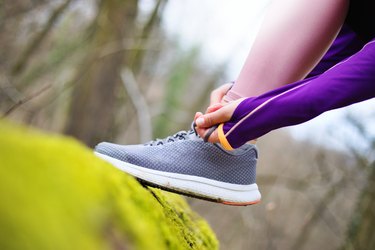
Designing a proper workout can feel overwhelming with the different types of exercises available. To break down the confusion, you should begin by incorporating the three components of a workout into your exercise regimen: cardiovascular, resistance and flexibility training.
Tip
The three parts of an exercise session are cardio for raising your heart rate, resistance for building muscle mass and flexibility for injury prevention.
Video of the Day
Video of the Day
Three Parts of Exercise Programs
To begin creating your own exercise program, you should familiarize yourself with its three basic components and why they matter to your overall health:
Cardio
Cardiovascular activity gets your heart pumping and can lessen your risk of heart disease, Type 2 diabetes and lung and colon cancers, according to the American Heart Association (AHA).
The Mayo Clinic says that cardio also provides non-disease-related benefits, such as burning calories and helping control your appetite, boosting your mood through the release of endorphins, bettering sleep and increasing stamina and endurance.
The physical activity recommendations from the AHA say that you should perform moderate-intensity aerobic exercise for at least 150 minutes per week (such as brisk walking, tennis and dancing) or 75 minutes of vigorous-intensity aerobic activities per week (such as hiking uphill, running and swimming laps). Ideally, you should get a combination of both spread throughout the week.
Resistance Training
During resistance training, you're breaking down muscle tissue and rebuilding it into larger muscle mass. Why should you do this? According to the Mayo Clinic, lean muscle mass decreases as you age, and if you don't replace lost muscle, the muscle will get replaced with fat. Strength also can help you achieve the following:
- Reduce the signs and symptoms of chronic conditions such as arthritis, depression and diabetes.
- Better your quality of life by increasing your balance and curtailing your risk of falling. As you grow older, maintaining your strength also gives you independence.
- Lessen your risk of osteoporosis by building bone density.
The AHA recommends moderate- to high-intensity strength training at least two days per week. This can be accomplished with free weights, weight machines or using your own body weight, such as by performing push-ups and pull-ups.
Flexibility
Harvard Health Publishing says that a well-stretched muscle allows you full of range of motion, can improve overall athletic performance, decreases your risk of workout injury and makes daily activities easier, such as bending, reaching and picking up objects.
According to the Mayo Clinic, following these flexibility recommendations will help you avoid workout injury:
- Don't consider stretching a warm up. You could hurt yourself stretching cold muscles and actually do more harm than good to your body.
- Stretch equally on both sides to strive for flexibility symmetry. Unequal flexibility can serve as a risk factor for injury.
- Focus on your major muscle groups, such as thighs, neck, shoulders, hips and lower back. Again, make sure you stretch both sides.
- Hold each stretch for about 30 seconds.
- Don't bounce around, as this can lead to tightness rather than limber muscles.
Warm Up and Cool Down
Before and after the three phases of an exercise program, you should also engage in a warm up and cool down. The warm up serves as the foundation of your exercise program and prepares both the body and mind for more strenuous activity by speeding up your heart rate and breathing. Harvard Health Publishing offers the following suggestions for warming up:
- Make it last for five to 10 minutes
- Work all major muscle groups
- Start slow and pick up the pace
During your cool down, you should work on flowing from one movement to the next and focusing on exercises that improve your range of motion, such as walking, stretching your legs and arms and even jumping in the pool for a couple of laps. If you're pressed for time, you can consider a walk to your car as a cool down to help alleviate blood pooling that causes lightheadedness.
Read more: The 30-Day Abs Challenge
- Harvard Health Publishing: “Exercise 101: Don't Skip the Warm-up or Cool-down”
- American Heart Association: "American Heart Association Recommendations for Physical Activity in Adults and Kids"
- Harvard Health Publishing: "Benefits of Flexibility Exercises"
- Mayo Clinic: "Weight Training: Improve Your Muscular Fitness"
- Mayo Clinic: "Stretching: Focus on Flexibility"
- Mayo Clinic: "Cardio 101: Benefits and Tips"